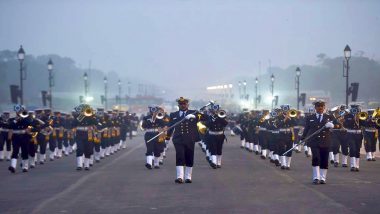We all know the basic facts about the Republic Day being celebrated on 26th January, here are some interesting and lesser-known facts on what happened on 26 January.
On 26 January 1930, India’s Independence Day was celebrated for the first time. Independence Day was celebrated on 26 January until independence on 15 August 1947. Despite India achieving independence on 15 August, 1947, its laws were still based on the colonial Government of India Act 1935. In order to give importance to the date of declaration of Purna Swaraj on 26 January 1930, the constitution was implemented on 26 January 1950 and 26 January was declared as Republic Day. Happy Republic Day 2022 Wishes, Patriotic Quotes and HD Images: WhatsApp Stickers, 'Jai Hind' HD Images, Telegram Messages, Signal Greetings and Facebook GIFs to Celebrate India’s 73rd Gantantra Diwas.
On 19 August, 1947, a resolution was moved for the appointment of the Drafting Committee that was responsible to draft a constitution. Dr BR Ambedkar was chosen as its chairman.
On 26 January 1950, India the Constitution of India came into effect, replacing the Government of India Act (1935). By adopting its own Constitution, India became a republic on 26 January. On that day, Dr Rajendra Prasad started his first term as President of India and the Constituent Assembly became the Parliament of India under the transitional provisions of the new Constitution.
This is the primarily known point on 26th January. Now let’s fast forward to the original copy of the constitution of India.
The Constitution of India is a fascinating piece of art also. It is a book which can guide India’s present and ensure India’s future while constantly acknowledging India’s past.
Sure, the Constitution is a document that protects our rights as citizens; but the rarely known fact is that each part of the Constitution begins with artworks that traces India’s 5000-year-old history. The intricate gold pattern on the front and back cover itself is borrowed from the famous Ajanta murals.
The original copy of the Constitution of India was entirely handcrafted by calligraphers and artists at Tagore’s Visva Bharati. It took 5 years to create these elaborate pieces of art. The calligraphy of this handwritten-handmade book is credited to Prem Behari Narain Raizada, illuminated in miniature style by Nandalal Bose and his student from Shantiniketan, a total of 22 illustrations, including Himalaya view, Indian desert scene and views of Indian sea.
The execution of line-drawings and gold-works that bear Nandalal Bose’s signature “Nand” on several pages were beautified by Beohar Rammanohar Sinha, signed either as “Ram” or “Rammanohar”.
The signature of Prem Behari Narain Raizada, signed as “Prem”, can be seen on the calligraphed page on Article 55 of the constitution of India.
The first part of the original document of the Constitution of India starts with a popular Indus Valley seal-mark, the bull. The rarity of this seal has continued to puzzle historians till date, as the humped bull is a recurring theme in many of the ritual and decorative arts of the Saindhav (Indus) region, appearing on painted pottery and as figurines long before the rise of cities and continuing on into later historical times.
The part on citizenship is represented by India’s Vedic Age, illustrated with the painting of a Gurukul.
Part 3, on fundamental rights is depicted by an illustration of Rama, Lakshman, Sita. Incidentally, Interestingly, this image of Ram was used for a verdict (on Ram Janmbhoomi dispute) and the court thus declared Rama to be a constitutional entity.
Part on Directive Principles of State Policy begins with the iconic scene of Arjun and Krishna’s conversation before the war.
The part of the constitution on rules related to the President and Vice President is illuminated with the image of Buddha’s Enlightenment.
Image of Mahavira, depicting a period of huge change in society is rendered in the page after it, that is the part 6.
Great artistic depiction is done again by rendering the image of Nataraja Chola Bronze on pages related to finance (Part 12). The Chola Bronze Nataraja was created as per the instructions of the Shilp Shastras.
(The above story first appeared on LatestLY on Jan 25, 2022 05:38 PM IST. For more news and updates on politics, world, sports, entertainment and lifestyle, log on to our website latestly.com).













 Quickly
Quickly


